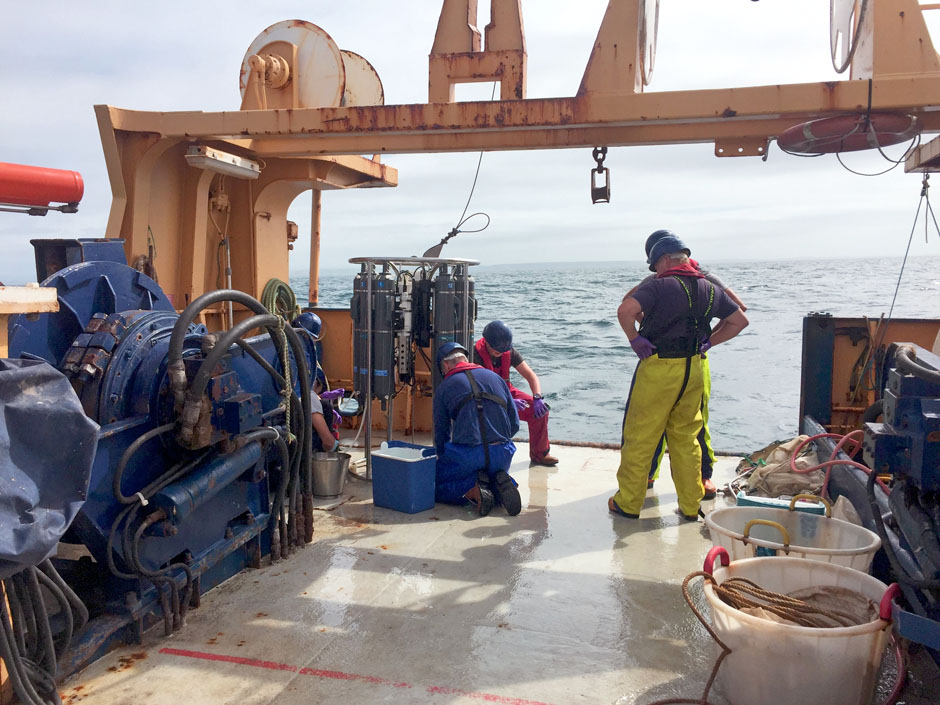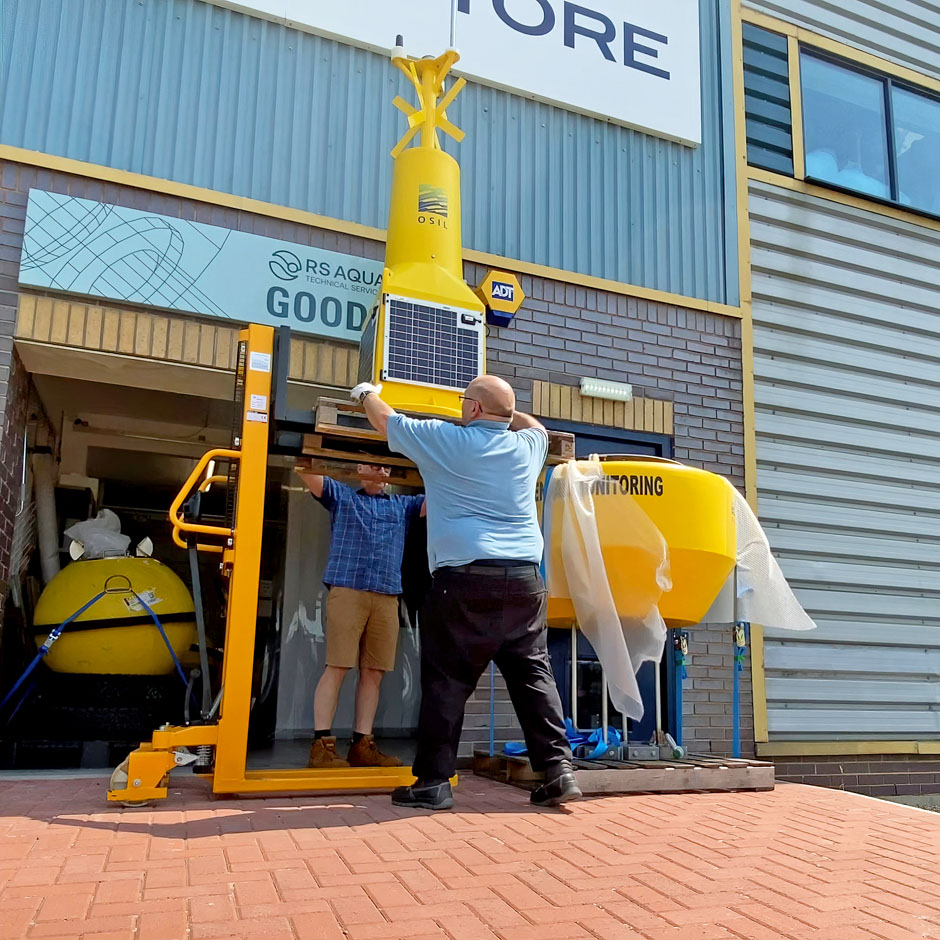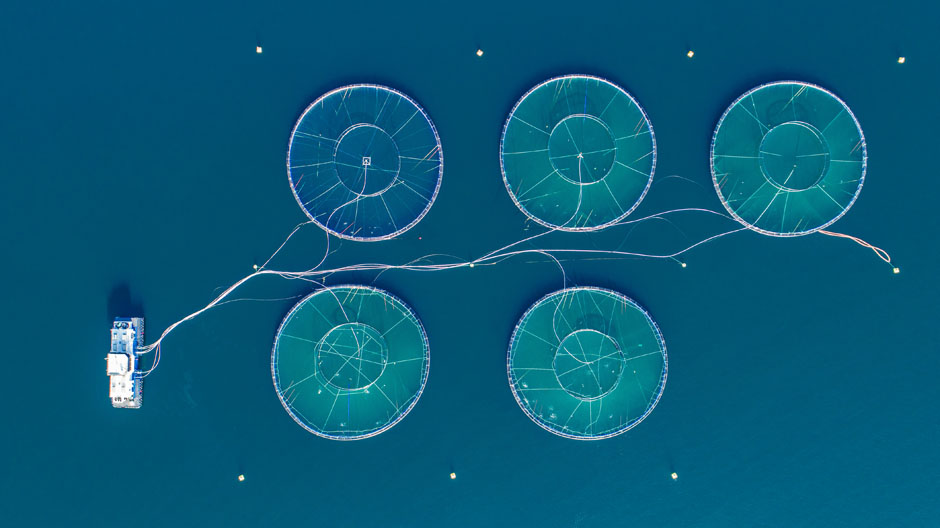Harmful Algal Blooms – Early Warning Systems to the Rescue
 HAB monitoring at aquacultures sites in the western English Channel, SW England (Credit Ross Brown, University of Exeter)
HAB monitoring at aquacultures sites in the western English Channel, SW England (Credit Ross Brown, University of Exeter)Naturally occurring algae in marine and freshwater ecosystems can proliferate under certain environmental conditions. This results in the deoxygenation of seawater or the release of toxic compounds that can harm or kill fish and shellfish. Biotoxins also concentrate within the meat of shellfish like oysters or mussels, threatening human health.
“These events tend to happen more frequently and/or last longer in summer when there is higher light intensity and greater stability of the water column,” said Dr. Ross Brown of the University of Exeter in the UK. “Tidal currents can transport high concentrations of algal cells toward the coast, where there is ample nutrient supply, and there are boundary conditions that contain the blooms for a period of time, allowing them to develop. Temperature and stratification in the water column favor some types of algae over others, while nutrients from agriculture or sewage discharge also potentially drive HABs.”

Ocean and Land Colour Images (OLCI) of a Emiliania huxleyi bloom (non-harmful) in the western English Channel, July 2018. (Credit Plymouth Marine Laboratory NCEO NEODAAS)
HABs can have devastating impacts on aquaculture. They range from small, local events that affect bays or beaches to larger blooms covering entire coastlines. They can also be fleeting or last a long time and result in significant disruptions such as delayed harvests or farm closures. Some algal species also affect the various life stages of fish and shellfish, resulting in a loss of products, lower quality products or a longer time for species to reach market size.
But, thanks to regimented monitoring systems on aquaculture sites, scientists can track changes in HAB development. In Scotland, salmon producers are trialing an early warning system for HABs developed by the UK ocean science technology provider RS Aqua, in partnership with sensor manufacturer Innovasea. Farms can find out in advance whether conditions are forming that might be conducive to HAB development on the farm itself, downstream or nearby. As well as highlighting where the risks are, the system can help farmers act quickly to avoid major damage. Monitoring parameters include temperature, chlorophyll, blue-green algae, turbidity, salinity, oxygen, current speeds and meteorological conditions.
“Many environmental parameters must come together for HABs to develop, and that’s hard to measure,” explained Ryan Mowat, Director of Fisheries and Research at RS Aqua. “The need for a solution to address this didn’t seem to be met, so that was our main push to get involved.”
RS Aqua’s test system includes a suite of sensors on a salmon farm and an oceanographic buoy positioned downstream. Data from all sensors are sent to the cloud for analysis, processed through algorithms and the results are used to establish a HAB risk index for farmers, who receive notifications in real time. Work is underway to develop a traffic-light system to categorize risk level and notify farms that there may be an increased risk because certain parameters are behaving in a particular way.

(Credit: RS Aqua)
One unique feature of RS Aqua’s system is Innovasea’s aquaMeasure sensors, which are completely wireless and easy to reposition as needed.
“We can put hundreds across a farm and they all speak to a single receiver at the surface,” said Mowat. “Traditionally, sensors on farms have individual cables running to the surface of each pen, and removing these entirely makes our system much more versatile and cost-effective.”
In the U.S., the National Oceanic and Atmospheric Administration (NOAA) funds forecasts, phytoplankton monitoring and research to mitigate the impact of HABs. One example is the SoundToxins program, which enables the early warning of shellfish-killing HABs for growers in Washington State. Growers and other partners conduct weekly water sampling to check for changes in phytoplankton levels at sites in Puget Sound and Washington’s outer coast, where HAB-related shellfish mortalities have occurred. Analyzing the water conditions that trigger blooms and seeing the impacts at varying levels of abundance lets SoundToxins warn farms in advance. This allows farmers to respond, for example by harvesting shellfish early or filtering seawater that is entering hatcheries.
Another example is the Pacific Northwest HAB Bulletin, which forecasts blooms of the toxic diatom Pseudo-nitzschia for coastal razor clam fisheries from Cape Flattery, Washington to Heceta Head in Oregon. It uses a type of technology called the Environmental Sensor Processor to gather data on algal cells and toxins and send information back to shore.
“Results are turned around fast and delivered in formats shaped by robust partnerships with growers, states and tribes,” said Marc Suddleson of the NOAA National Ocean Service. “Growers and managers value a single product synthesizing data on marine conditions that cause toxic blooms, and a forecast to help them assess HAB risks. All that, delivered in time, prevents costly impacts and maintains confidence that our seafood is safe.”

(Credit: RS Aqua)
Suddleson notes that one important step in evolving HAB early warning systems is to support partnerships with aquaculture and fisheries scientists and include growers in planning and research. Another is to provide training in algae and phytoplankton identification or conferences on harmful algae to build awareness and yield solutions.
Scientists believe that HABs could continue to shift and move as climate change affects ocean temperatures and circulation, but it isn’t clear whether this will occur everywhere. Warming oceans may lengthen seasonal opportunities for algal growth, or changing ocean acidity or other conditions may lead to a shuffling of the distribution of HAB species. Long-term monitoring data for all regions or countries will be required.
“In the US, every region is impacted by HABs and they appear to be becoming more frequent,” said Suddleson. “This is why we must provide information to growers and managers in sufficient time so they can reduce the risks and uncertainty around HABs.”


0 comments